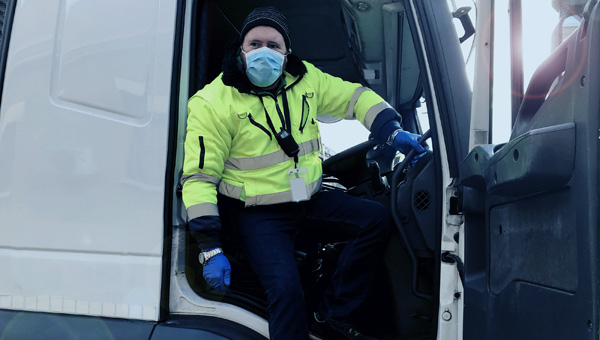Overcoming three challenges to delivery efficiency during unprecedented times
The current Corona Virus Pandemic has presented challenges for every industry, organisation and individual across the world.
 In particular, the increased pressures that have been placed on ensuring efficient deliveries; to stores and to homes – have never been experienced before.
In particular, the increased pressures that have been placed on ensuring efficient deliveries; to stores and to homes – have never been experienced before.
With the Government placing the UK on Police-enforced lockdown, panic-buying ensued and with the public unable to purchase items from physical stores ecommerce demand has seen huge growth, with a resultant exponential increase in the number of home deliveries for all types of goods. So what are the main pinch points for delivery that have been caused by the crisis, and how can they be addressed?
Deliveries to store and panic buying
In light of panic-buying and stockpiling caused as a result of the outbreak, many supermarkets struggled to keep up with demand and keep shelves stocked. Certain measures came into effect to support retailers, such as the relaxation of the enforcement of the EU drivers’ hours rules, as well as changes to MOT testing requirements on commercial vehicles to keep deliveries moving. But while these initiatives contributed to the overall effort to streamline delivery to stores, with the temporary lack of regulated checks, implementing vehicle safety technology to make sure vehicles are roadworthy and drivers are safe when they go out is more important than ever before.
Additionally, the government announced that it temporarily relaxed elements of competition laws to allow retailers to work together and share resources to take some pressure off of supply chains; sharing stock data, pooling staff, delivery depots and vans, as well as coordinating opening hours to allow for shelf stacking time. When it comes to sharing delivery capabilities, an online, remote, centralised system is essential, so that everybody can access it in order to provide maximum visibility and capitalise on technology to get more out the existing resources in place, as they come under increasing pressure.
Supermarkets closed overnight to allow for deliveries and stacking to take place. This is where dock appointment scheduling becomes a critical component, to be able to manage demand in line with resources and capacity, to prioritise deliveries and create a foundation for better carrier/supplier collaboration – addressing this significant pinch point during a critical time can help to streamline the delivery process. One well known supermarket coped at four times its peak with the use of Dock Appointment Scheduling, demonstrating how effective the tool can be.
Home Deliveries during unprecedented times
Add to all of this the growing concerns over the delivery driver shortages, especially as many may have had to self-isolate depending on whether they experience symptoms or not, the use of technology to optimise delivery efficiency has never been more important.
Steps have also been put in place by delivery companies relating to the actual delivery at the addressees’ homes, including leaving the goods in a specific place and not requiring a signature from the person accepting the item for proof of delivery.
A routing and scheduling solution that continually assesses the resources available, versus actual demand and provides visibility throughout the supply chain, from initial collection through to the last mile of the home delivery process, offers the opportunity to maximise operational efficiency. Integrated telematics and mobile data communications provide increased visibility for the fleet manager and consumer, as they can see in real-time, exactly where a vehicle is against the plan and route set out by the scheduling software. This added insight allows transport operators to add or amend jobs to avoid disruption, such as traffic, as well as send automatic updates to the customer about any changes to their delivery. One well known pharmacy that relies on semi-retired drivers – those at higher risk to Coronavirus – is coping with a 15% absence rate with the use of routing software, demonstrating how the technology is enabling the pharmacy to keep up despite driver shortages.
With temporary changes to drivers’ hours law enforcement, by combining digital tachograph analysis and reporting with driving licence and driver CPC verification with the DVLA, as well as digital driver vehicle safety checks, all in one platform, operators can practice proactive compliance management to underpin optimisation of fleet efficiency. Operators need a simple and convenient way to stay on top of their compliance requirements, especially as more changes are likely to come into effect as the situation unfolds.
Growth of eCommerce during Covid19 pandemic
With the public turning to online delivery during lockdown, businesses that have not had an online presence have realised that given the current state, this could mean the difference between surviving and going under. Even for those businesses with ecommerce in place, they have likely never had to deal with such an unprecedented crisis we are currently facing.
Conclusion
With technology that provides continuous background optimisation of resources, operators can get more out of their existing resources. Drivers and the public can be kept safe with real-time updates on delivery ETAs and mobile applications for proof that your goods were left in a safe place or outside your door for ‘contactless delivery’. These are testing times for every business, but those that can adapt now and capitalise on technology that can unlock valuable efficiencies will be the ones that will come out the other side stronger and in a better position to ride the wave of future demand fluctuations.
If you have faced any of these issues during 2020 then contact us to understand how our logistics solutions can help with deliveries and compliance.


